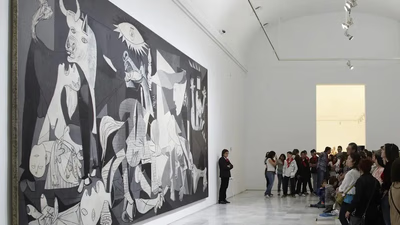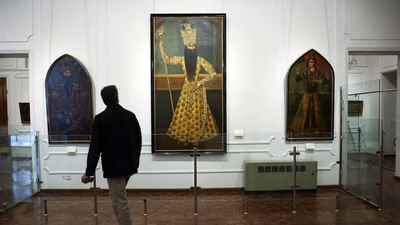
Exploring painting artworks in global markets and trade insights.
In the world markets, some paintings have a higher export value than others. Of course, the export value of any painting artwork depends on several factors such as the artist's reputation, artistic style, history, market conditions and demand, the size and quality of the works, and the artistic communities associated with them. Painting artworks with high historical and cultural value usually have the ability to attract attention and demand in the world market. Examples of these works include paintings by great artists such as Leonardo da Vinci, Vincent van Gogh, Picasso, Rembrandt and Monet.
The works of famous contemporary artists also usually have a high export value. Artists such as Andy Warhol, Jackson Pollock, Domenico Kyoto and John Baldessari are known for their works in the global market. Works that are painted in a specific and unique style are usually more attractive for export. For example, impressionist paintings such as the works of Claude Monet, serialist paintings such as the works of Salvador Dali, or hyperrealistic paintings such as the works of Juan Miró can be considered in the world market.
Painting works of art are priced based on artistic value, artist's reputation, size, date of manufacture and market condition. The price should be fair and attractive to the target buyers. Participating in local and international art fairs and exhibitions is an opportunity for artists and art dealers to display and sell their artworks. These events allow artists and art dealers to connect with buyers, gallerists, collectors and other relevant people in the art industry.
Nowadays, the marketing and sale of painting works of art is also done through online sources. Websites and online platforms that sell art can help artists and art dealers reach a wider audience. Each country has its own rules and regulations regarding the export of works of art. In order to export paintings, one must study and comply with the export laws and regulations of each country in question. This includes licenses, restrictions and financial requirements and legal documentation. In order to export painting works of art, it is usually necessary to obtain relevant permits from the local authorities.
If exporting works of art to a particular country is too complicated, cooperation with local intermediaries and representatives can be beneficial for exporters. These intermediaries can act as agents by facilitating communication, providing guidance on local laws and regulations, and building relationships with local customers. For the export of paintings, strong and safe packaging is necessary so that the works are not damaged during transportation. It is also important to use safe and reliable transportation methods.
Continuous communication with customers and target buyers through appropriate marketing methods, including the use of social media, e-mails, websites, and art exhibitions, is critical to attracting new customers and maintaining relationships with existing customers. For the export of paintings, it is necessary to comply with the relevant financial and tax laws, including paying taxes and protecting the intellectual property rights of the works of art.
Artists, galleries, and art dealers usually select paintings based on artistic value, market value, and demand. Works that attract more attention and marketability are usually considered for export. Comprehensive research is done on target markets and demand for paintings. This includes studying the market, identifying competitive products, analyzing demand and knowing the laws and regulations of art export in the countries in question. Painting artworks that introduce innovative ideas and styles for the first time can have a high export value.
-

The Middle East has a rich cultural heritage in art and painting, with a strong interest in buying and selling artworks. This region values painting not only for its aesthetic appeal but also for its cultural and religious significance. Various platforms such as art exhibitions, auctions, and galleries facilitate the trade of artworks, with notable markets like the Tehran Art Market in Iran. While the level of interest in art transactions may vary due to economic conditions and individual tastes, the Middle East remains a significant player in the global art scene. Museums across the region house masterpieces from renowned artists like Francis Bacon, Vincent Van Gogh, and Leonardo da Vinci, attracting collectors and investors alike. Wealthy individuals in countries such as the UAE, Qatar, and Saudi Arabia view art as a viable investment opportunity. The market is also receptive to contemporary works, with numerous events showcasing emerging artists. Overall, the Middle East is recognized as a vibrant marketplace for both classical and modern art.
-

Islamic art in West Asia showcases a rich tapestry of styles influenced by cultural and religious elements. Characterized by geometric patterns, calligraphy, and vibrant colors, it includes Persian miniature paintings that depict intricate scenes from literature and history. The Qajar dynasty significantly impacted regional art with opulent portrayals of court life. Various painting styles exist, such as landscape, religious, carving, and mystical paintings, each reflecting the region"s diverse heritage. Miniature paintings are particularly notable for their detailed depictions of fictional narratives. In mosques and shrines, complex geometric designs and calligraphic art enhance the spiritual ambiance. Contemporary artists in West Asia continue to innovate, addressing social and political themes through diverse mediums. This blend of traditional and modern influences highlights the ongoing evolution of Middle Eastern art. "
-

Art exhibition centers in West Asia serve as key venues for collecting and supplying artworks, focusing on reputation, volume, and value. Auctions play a significant role in the art market, facilitating public sales of artworks in major cities. Notable galleries include the Dubai National Art Gallery, Tehran Museum of Contemporary Art, and Doha Museum of Contemporary Art, each showcasing a diverse range of contemporary and classical art. The Tehran Art Bazaar and Aftab area in Dubai are prominent markets for buying and selling art, hosting various exhibitions and auctions. The King Fahd Center for Culture and Arts in Riyadh and Istanbul Art Auction are also vital to the region"s art scene. Some of the most expensive paintings sold include "Crocodile" by Xavier Camelot and "Board" by Parviz Tasfazi, highlighting the high-value transactions occurring within these markets. Overall, these galleries and auctions underscore their importance in shaping the art industry in West Asia. "
-

The export value of painting artworks is influenced by various factors, including the artist"s reputation, artistic style, historical significance, and market demand. Renowned artists like Leonardo da Vinci and Vincent van Gogh command high prices due to their cultural impact. Contemporary artists such as Andy Warhol also have significant export value. Unique styles, such as impressionism and hyperrealism, enhance marketability. Participation in art fairs and exhibitions provides opportunities for artists to connect with buyers and collectors. Online platforms are increasingly important for reaching wider audiences. Compliance with export laws is crucial; this includes obtaining necessary permits and understanding local regulations. Strong packaging and reliable transportation methods are essential to prevent damage during transit.
Effective marketing strategies, including social media engagement and email communication, help maintain customer relationships. Researching target markets is vital for identifying demand and competitive products. Innovative artworks can achieve higher export values. "




